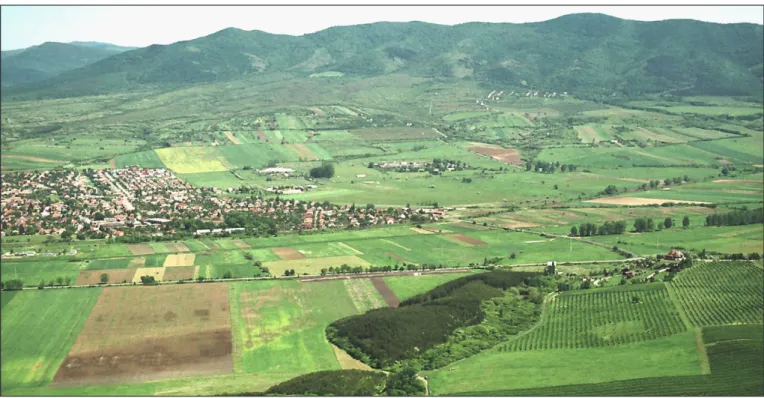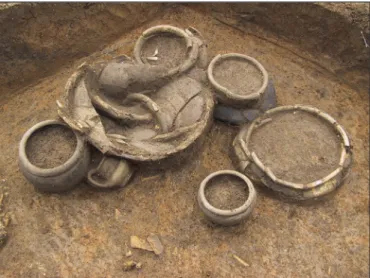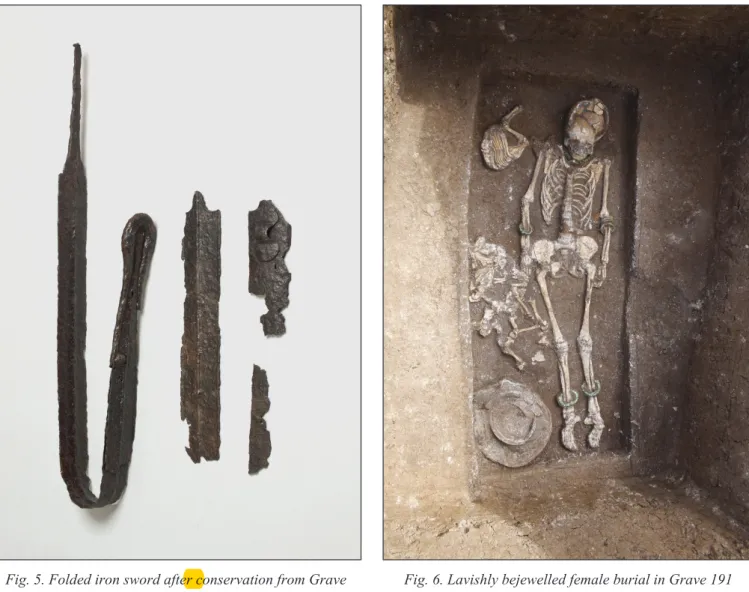CELTS IN THE MÁTRA REGION
Károly TanKó1
The Mátra region is particularly rich in archaeological finds of the Late Iron Age. Only scanty data were available on the period’s history until the fist major cemetery excavation was undertaken on the outskirts of Mátraszőlős in the 1950s. The number of known sites in this region increased substantially in the wake of the major industrial and other development projects after the turn of the millennium. In addition to several settlement excavations, the two Late Iron Age burial grounds uncovered at Ludas and Gyöngyös have yielded a remarkably rich array of Celtic finds and have provided fresh insights into Celtic society and the Celts’ customs and lifeways.
Part of the Northern Mountain Range of volcanic origin, the Mátra Mountains are separated from the Cserhát Mountains by the River Zagyva in west and from the Bükk Mountains by the Tarna Valley in the east. The two highest peaks of Hungary rise in this roughly 25 x 50 km large area (Kékes: 1014 m, and Galya-tető: 965 m). Owing to its geographic location and diverse terrain, the region has an extremely diverse microclimate with a mosaic patterning.
It has since long been known that north-eastern Hungary in general, and the Mátra region is particular, is extremely rich in Late Iron Age finds. There are few modern settlements on whose territory Celtic finds and burials have not been found.2
1 Interdisciplinary Archaeological Research Group of the Hungarian Academy of Sciences and the MTA-ELTE Research Group for Interdisciplinary Archaeology.
2 Hunyadi, Ilona: Kelták a Kárpát-medencében. Leletanyag. Régészeti Füzetek 2 (1957) 161–175; Patay, Pál: Újabb kőkori és kelta leletek Nógrádkövesden és a Nógrádi dombvidéken. ArchÉrt 83 (1956) 186–191; Hellebrandt, Magdolna: Celtic Finds from Northern Hungary. In: Kovács, Tibor – F. Petres, Éva – Szabó, Miklós (eds.): Corpus of Celtic Finds in Hungary 3. Budapest 1999, 147–182; Almássy, Katalin: Vázlat a nógrádi dombvidék kelta településtörténetéhez. In: Guba, Szilvia – Tankó, Károly (eds.):
„Régről kell kezdenünk…”. Studia Archaeologica in honorem Pauli Patay. Régészeti tanulmányok Nógrád megyéből Patay Pál tiszteletére. Szécsény 2010, 195–203; Almássy, Katalin: A Mátraszőlős-királydombi kelta temető I. NyJAMÉ 54 (2012) 71–215.
Fig. 1. The foothills of the Mátra Mountains (photo: Gábor Farkas)
The period’s history was only known from scanty data until the first major cemetery excavation was undertaken on the outskirts of Mátraszőlős in 1957–1958, when Road 21 was built. Pál Patay uncovered sixty-three graves in the area known as Királydomb during the earth-moving operations; of these, one was an inhumation burial, the rest were cremation burials. Hungarian archaeology has redeemed one of its long-standing debts with the publication of the site and its finds.3 Although a detailed assessment of the cemetery and its finds is still lacking, it is clear that the grave goods from the burials are quite remarkable and provide important information for the better understanding of the region’s Late Iron Age.
In 2003, Andrea Vaday uncovered part of a Late Iron Age settlement near the cemetery. The excavated buildings were near-contemporaneous with the burials and yielded almost exclusively pottery fragments.
The pottery from the settlement represents a blend of the ceramic traditions of the Scythian-type material culture of the Hungarian Plain and the pottery traditions of the Celtic population arriving from the west.4 This is not a unique phenomenon in eastern Hungary: a similar cultural duality reflecting the co-residence of the Scythian and Celtic population could also be demonstrated in the pottery from Sajópetri in the Sajó Valley and from Polgár, a settlement on the River Tisza.5 Owing to the fortuitous find circumstances, Scyth- ian-Celtic co-residence and cultural blending can now also be demonstrated in the foothills of the Mátra Mountains and in the Zagyva Valley.6
The assessment and publication of the Celtic cemetery excavated at Ludas as part of the Iron Age research project of the Eötvös Loránd University in Budapest represented a major milestone in the reconstruction of Late Iron Age society in the Mátra foothills.7 The site owes its prominence in international research not only to its finds, but also to the modern interdisciplinary field and excavation techniques employed during its investigation and the final report covering all aspects of the site. Similarly to Mátraszőlős, the eighty-two burials of the cemetery were predominantly crema-
tion burials; the graves included no more than five inhumation burials. The traditional typochronolog- ical and combination statistical (seriation) analyses indicated that the biritual cemetery had been used from the late fourth century to the early second cen- tury BC, corresponding to La Tène B2a-B2b-C1 phases (Gebhard’s Horizons 4-5-6).8 A closer look at the spatial organisation of the cemetery has contrib- uted to our understanding of the social position of the Celtic warrior elite. Six grave clusters could be distinguished at Ludas: the central area of the burial ground accommodated the graves of the community’s most prominent members, the warriors interred with their swords, spears and shields. The grave clusters
3 Patay, Pál: Celtic finds in the mountainous region of Northern Hungary. ActaArchHung 24 (1972) 353–358. Almássy, Katalin:
A Mátraszőlős–királydombi kelta temető I.
4 Tankó, Károly – Vaday, Andrea: Késő bronzkori és késő vaskori telepleletek Mátraszőlős-Királydombról. In: Guba, Szilvia – Tankó, Károly (eds.): „Régről kell kezdenünk…”. Studia Archaeologica in honorem Pauli Patay. Régészeti tanulmányok Nógrád megyéből Patay Pál tiszteletére. Szécsény 2010, 137–157.
5 Szabó, Miklós – Tankó, Károly – Szabó, Dániel: Le mobilier céramique. In: Szabó, Miklós (ed.): L’habitat de l’epoque de La Tène à Sajópetri – Hosszú-dűlő. Budapest 2007, 229–252; Szabó, Miklós – Czajlik, Zoltán – Tankó, Károly – Timár, Lőrinc:
Polgár 1: l’habitat du second Âge du Fer (IIIe siecle av. J-Chr). ActaArchHung 59 (2008) 183–223.
6 Tankó, Károly: La Tène ceramic technology and typology of settlement assemblages in Northeast Hungary. In: Berecki Sándor (ed.) Iron Age Communities in the Carpathian Basin: Proceedings of the International Colloquium from Târgu Mureş.
Cluj-Napoca 2010, 321–332.
7 Szabó, Miklós (dir.) – Tankó, Károly (ass.) – Czajlik, Zoltán (ass.): La nécropole celtique à Ludas–Varjú-dűlő. Budapest 2012.
8 Szabó, Miklós – Tankó, Károly: La nécropole celtique à Ludas-Varjú-dűlő. In: Szabó, Miklós (dir.) – Tankó, Károly (ass.) – Czajlik, Zoltán (ass.): La nécropole celtique à Ludas-Varjú-dűlő. Budapest 2012, 141–149.
Fig. 2. Excavation of the cemetery at Ludas (photo: Gábor Farkas)
of the more lavishly furnished female and child bur- ials, of the armed clientele and of the poorer graves formed a semi-circle around the central group. In addition to the weaponry, the magnificent openwork bronze bracelet and gold finger-ring in the wealthy warrior’s grave in the cemetery’s centre symbolised the deceased’s prominent social status.9 Aside from weapons and jewellery, the Ludas burials yielded a high number of vessels, most of which contained food and drink offerings deposited as part of the bur- ial rite and thus their study offers a glimpse into the Celts’ burial customs. The grave pottery was usually placed in one specific part of the grave. The num- ber and typological distribution of the vessels indi- cate that most graves were furnished with three ves- sel types (pots, mugs and bowls), a practice earlier observed in other cemeteries too.10 At the same time, the burials of one grave cluster were provided with an exceptionally high number of vessels, ranging from five to seven pieces. In these cases, the grave pottery was made up of the three basic types (pots, mugs and bowls) and various other vessels such as one-handled cups, hand-thrown vessels and graphitic situlas with combed decoration, i.e. a large vessel set. However, the comparison and collation of the number of clay vessels with the other grave goods and the amount of animal bones, indirect proof of food offerings, did not yield any regular patterns.11
While 98% of the Ludas grave pottery was wheel- turned, in some cases, hand-thrown barrel-shaped or conical bowls were deposited in the burials. The lat- ter represent a continuation of local Early Iron Age traditions and attest to the co-residence or blend of the Celts arriving from the west (La Tène culture) and the local Scythian-period population (Veker- zug culture).12 However, further studies are needed in this respect: the assessment of the ninety burials of the cemetery near Sajópetri uncovered between 2004 and 2006, currently underway, will probably yield a wealth of new information and results simi- lar to those from Ludas.13
9 Szabó–Tankó 2012, 147–149; Szabó, Miklós: Kelták Magyarországon. In: Szabó, Miklós – Borhy, László: Magyarország története az ókorban: Kelták és rómaiak. Bibliotheca Archaeologica 4. Budapest 2015, 42–43.
10 Bujna, Jozef: Die latènezeitliche Gräberfeld bei Dubník. II. Analyse und Auswertung. SlovArch 39 (1991) 221–255.
11 Szabó–Tankó 2012, 138–140.
12 The research project and the present study was generously funded by the MTA-ELTE Research Group for Interdisciplinary Archaeology and the Bólyai János Grant of the Hungarian Academy of Sciences.
13 Szabó, Miklós: La Tène-kori temető Sajópetri határában. La Tène period cemetery at Sajópetri. Régészeti Kutatások Magyarországon – Archaeological Investigation in Hungary 2005 (2006) 61–71.
Fig. 3. Grave pottery in Grave 1051 at Ludas (photo: Gábor Farkas)
Fig. 4. Iron weapons from Grave 186 at Gyöngyös (photo: Károly Tankó)
Richly furnished burials of the Late Iron Age came to light on the outskirts of Gyöngyös during a salvage excavation ahead of an industrial development project in 2016. The site was excavated jointly by the Dobó István Museum of Eger and the Institute of Archaeological Sciences of the Eötvös Loránd University. Over two thousand artefacts were recovered from the 154 burials which can be associated with the Celts settling in the foreland of the Mátra Mountains in the third–second centuries BC. There were 125 cremation, nine- teen inhumation and two symbolic burials. The latter contained no ashes, merely iron weapons deposited in a heap in the middle of the grave pit. The deceased was generally laid on the back in an extended position in the inhumation burials, while several rites could be distinguished among the cremation burials. The cre- mains most often lay in a small heap on the floor of the grave pit, but in a few cases, they were placed in an urn. Very rarely, the calcined bones were scattered in the fill of the grave. The grave goods reflect a highly militant population because, similarly to Mátraszőlős and Ludas, weapons (swords, spears and shields) account for a fairly high number among the grave goods. The female burials were richly furnished with jewellery representing the typical female costume accessories: brooches, bracelets, anklets and a variety of chain necklaces.14
In sum, we may say that had the Mátraszőlős cemetery excavated in the 1950s according to the standards of the day been published soon after the conclusion of the fieldwork, it would have contributed much to a better understanding of the Iron Age in the Mátra region. The settlement section uncovered at Mátraszőlős
14 Tankó, Károly – Tóth, Zoltán – Rupnik, László – Czajlik, Zoltán – Puszta, Sándor: Short report on the archaeological research of the Late Iron Age cemetery at Gyöngyös. Dissertationes Archaeologicae ex Instituto Archaeologico Universitatis de Rolando Eötvös Nominatae Ser. 3, No. 4 (2016) 307–324.
Fig. 6. Lavishly bejewelled female burial in Grave 191 at Gyöngyös (photo: Károly Tankó)
Fig. 5. Folded iron sword after conservation from Grave 59 at Gyöngyös (photo: Nándor Horváth)
after the turn of the millennium revealed that similarly to the other Late Iron Age settlements in the north- ern Hungarian Plain, the western foothills of the Mátra Mountains was characterised by the co-residence and cultural blending of the Scythian and Celtic population. The cemetery at Ludas, whose investigation involved the application of modern field techniques and meticulous documentation as well as an interdis- ciplinary assessment of the site, offered a uniquely detailed picture of the funerary practices of a Celtic community, its customs and costume, as a result of which we now have a better understanding of Late Iron Age society. The Gyöngyös cemetery excavated in 2016 meant a major advance in our knowledge of this period in several respects. The cemetery eclipses all previous burial grounds in north-eastern Hungary in terms of its many burials and grave goods, while the many advances in research techniques brought with it the application of magnetometer surveys, drones and 3D photogrammetric documentation during the site’s investigation, yielding a wealth of high-quality information that foreshadows a deeper knowledge of the Celtic period in the Mátra region.
RecommendedReading: Szabó, miklóS:
Kelták Magyarországon. In: Szabó, Miklós – Borhy, László: Magyarország története az ókorban: Kelták és rómaiak. Bibliotheca Archaeologica 4. Budapest 2015.
Szabó, miklóS (diR.) – Tankó, káRoly (aSS.) – czajlik, zolTán (aSS.):
La nécropole celtique à Ludas-Varjú-dűlő. Budapest 2012.
Tankó, káRoly – TóTh, zolTán – Rupnik, láSzló – czajlik, zolTán – puSzTa, SándoR:
Short report on the archaeological research of the Late Iron Age cemetery at Gyöngyös. Dissertationes Archaeologicae ex Instituto Archaeologico Universitatis de Rolando Eötvös Nominatae Ser. 3, No. 4 (2016) 307–324.
Fig. 7. Bronze hollow-knobbed anklet from Grave 43
at Gyöngyös (photo: Szidónia Pál) Fig. 8. 3D photogrammetic reconstruction of Grave 73, a warrior’s burial, at Gyöngyös (made by László Rupnik)




